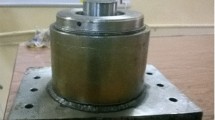Abstract
Metal cutting processes involve interaction of the machining forces with the work piece. In this processes the vibrations are induced in machine tools which have adverse effect on tool life, surface integrity and occurrence of undesirable chatter phenomenon. In order to enhance the quality of surface of the work piece after machining and avoid chatter marks and breakage of tool, this paper gives a unique method to detect and suppress the chatter effect on the work piece finis. This method incorporates the features of Magneto-Rheological fluid which utilizes the input current as source to modify the magnetic field to enhance the variable stiffness and produce damping effect to control the end mill cutter vibration and suppress the chatter. The variables stiffness and damping can be maintained by the damper input current to attain desired magnetic field in the MR damper. In this work the chatter detection is observed by means of a remarkable Bingham number. The different machining parameters are considered in the experimental work and the results are compared with and without the magneto rheological damping effect and the results shows the enhancement of surface quality and reduced the chatter marks on the work piece by producing Magneto-Rheological damping to the end mill cutter during machining.
Similar content being viewed by others
References
Alauddin, M., El Baradie, M. A., and Hashmi, M. S. J., “Optimization of Surface Finish in End Milling Inconel 718,” Journal of Materials Processing Technology, Vol. 56, No. 1–4, pp. 54–65, 1996.
Bouzid, W., “Cutting parameter optimization to minimize production time in high speed turning,” Journal of Material Processing Technology, Vol. 161, No. 3, pp. 388–395, 2005.
Davim, J. P. and António, C. A. C., “Optimization of Cutting Conditions in Machining of Aluminium Matrix Composites using a Numerical and Experimental Model,” Journal of Materials Processing Technology, Vol. 112, No. 1, pp. 78–82, 2001.
Dimla, D. E. and Lister, P. M., “On-Line Metal Cutting Tool Condition Monitoring. I: Force and Vibration Analyses,” International Journal of Machine Tools & Manufacture, Vol. 40, No. 5, pp. 739–768, 2000.
Diniz, A. E. and de Oliveira, A. J., “Optimizing the use of dry cutting in rough turning steel operations,” International Journal of Machine Tools & Manufacture, Vol. 44, No. 10, pp. 1061–1067, 2004.
Aggarwal, M. L., Gupta, B. C., Chaudhury, S. R., and Walker, H. F., “Interaction Graphs For A Two-Level Combined Array Experiment Design,” Journal of Industrial Technology, Vol. 18, No. 4, pp. 2–10, 2002.
Ezugwu, E. O., Fadare, D. A., Bonney, J., Da Silva, R. B., and Sales, W. F., “Modelling the correlation between cutting and process parameters in high-speed machining of Inconel 718 alloy using an artificial neural network,” International Journal of Machine Tools & Manufacture, Vol. 45, No. 12–13, pp. 1375–1385, 2005.
Wang, X. and Feng, C. X., “Development of Empirical Models for Surface Roughness Prediction in Finish Turning,” International Journal of Advanced Manufacturing Technology, Vol. 20, No. 5, pp. 348–356, 2002.
Feng, C. X., “An Experimental Study of the Impact of Turning Parameters on Surface Roughness,” Proceedings of the Industrial Engineering Research Conference, Paper No. 2036, 2001.
Ferriera, J. R., Coppini, N. L., and Miranda, G. W. A., “Machining optimization in carbon Fibre reinforced composite materials,” Journal of Materials Processing Technology, Vol. 93, pp. 135–140, 1999.
Ghani, J. A., Choudhury, I. A., and Hassan, H. H., “Application of Taguchi method in the optimization of end milling parameters,” Journal of Materials Processing Technology, Vol. 145, No. 1, pp. 84–92, 2003.
Hou, T.-H., Su, C.-H., and Liu, W.-L., “Parameters optimization of a nano-particle wet milling process using the Taguchi method, response surface method and genetic algorithm,” Powder Technology, Vol. 173, No. 3, pp. 153–162, 2007.
Lee, S. S. and Chen, J. C., “On-line surface roughness recognition system using artificial neural networks system in turning operations,” International Journal of Advance Manufacturing Technology, Vol. 22, No. 7–8, pp. 498–509, 2003.
Macodiyo, D. O. and Soyama, H., “Optimization of cavitation peening parameters for fatigue performance of carburized steel using Taguchi methods,” Journal of Materials Processing Technology, Vol. 178, No. 1-3, pp. 234–240, 2006.
Malakooti, B. and Raman, V., “An interactive multi-objective artificial neural network approach for machine setup optimization,” Journal of Intelligent Manufacturing, Vol. 11, No. 1, pp. 41–50, 2000.
Lefeuver, E., Audigier, D., Richard, C., and Guyomar, D., “Buck-boost converter for sensorless power optimization of piezoelectric energy harvester,” IEEE Transaction on Power Electronics, Vol. 22, No. 5, pp. 2018–2025, 2007.
Munlin, M., Makhanov, S. S., and Bohez, E. L. J., “Optimization of rotations of a five-axis milling machine near stationary points,” Computer-Aided Design, Vol. 36, No. 12, pp. 1117–1128, 2004.
Soeby, K., “Inverse kinematics of five-axis machines near singular configurations,” Int. J. Mach. Tools Manuf., Vol. 47, No. 2, pp. 299–306, 2007.
Author information
Authors and Affiliations
Corresponding author
Rights and permissions
About this article
Cite this article
Ahmed, G.M.S., Reddy, P.R. & Seetharamaiah, N. Experimental investigation of magneto rheological damping effect on surface roughness of work piece during end milling process. Int. J. Precis. Eng. Manuf. 13, 835–844 (2012). https://doi.org/10.1007/s12541-012-0109-0
Received:
Accepted:
Published:
Issue Date:
DOI: https://doi.org/10.1007/s12541-012-0109-0



